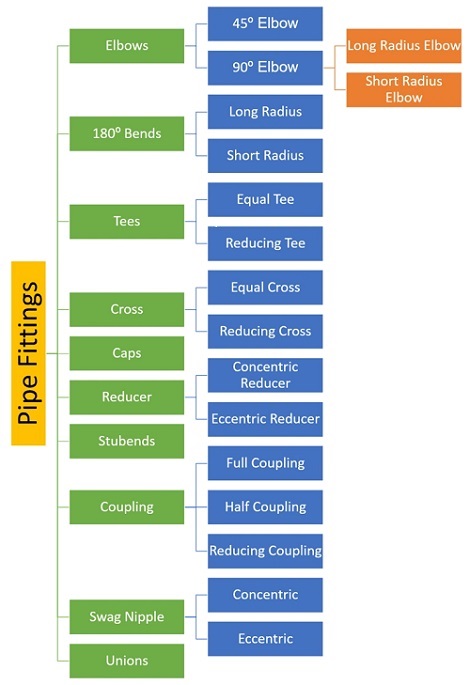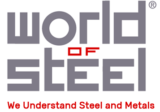Types of Fittings
Types of Fittings
- Why to use fittings?
Connect straight sections of pipe or tube Adapt to different sizes or shapes Regulating fluid flow
- Adapter
Adapters are used when connecting two pipes of different types. For example, an adapter could be fitted on the end of a plain pipe to allow a threaded connection at the other side of the adapter.
- Elbow
The Elbow is used more than any other pipe fittings. It provides flexibility to change the pipe direction. Elbows are mainly available in two standard types 90° and 45.However, it can be cut to any other degree. Elbows are available in two radius types, Short radius (1D) and Long Radius (1.5D).
- Coupling
A coupling connects two pipes. There are two types of couplings: “regular” and “slip”.A regular coupling has a small ridge or stop internally, to prevent over-insertion of a pipe. A slip coupling is deliberately made without this internal stop, to allow it to be slipped into place in tight locations. If the two ends of a coupling are of different standards or joining methods, the coupling is called an adapter. A coupling whose ends use the same connection method but are of different sizes is called a reducing coupling or reducer.
- Union
A union also connects two pipes, but is quite different than a coupling, as it allows future disconnection of the pipes for maintenance.
A union allows easy connection and disconnection, multiple times if needed. It consists of three parts: a nut, a female end and a male end. When the female and male ends are joined, the nut seals the joint by pressing the two ends tightly together.
- Dielectric Union
Dielectric unions, with dielectric insulation, separate dissimilar metals (such as copper and galvanized steel) to prevent galvanic corrosion.
- Nipple
A nipple is a fitting, consisting of a short piece of pipe, usually provided with a male pipe thread at each end, for connecting two other fittings. It can be concentric or eccentric.
- Reducer
Reducer may refer to any fitting which causes a change in pipe diameter to meet hydraulic pressure requirements depending on the Mach number.
- Double-tapped bushing
A double-tapped bushing is a fitting which serves as a reducer. It is a sleeve similar to a close nipple, but is threaded on both its inner and outer circumferences. It is more compact with a smaller female thread.
- Tee
A tee, the most common pipe fitting, is used to combine or divide fluid flow. ees can have one inlet and two outlets at 90-degree angles in the shape of a “T” and are used to split a supply line, or they can combine two lines into one outlet. They can be equal or reducing.
- Diverter tee
This specialized type of tee fitting is used primarily in pressurized hydronic heating systems, to divert a portion of the flow from the main line into a side branch connected to a radiator or heat exchanger.
- Cross
They are four-way fittings or cross branch lines, have one inlet and three outlets, and often have solvent-welded socket or female-threaded ends. Cross fittings may stress pipes as temperatures change due to the overdeveloped stress by the geometric shape.
- Cap
Caps, usually liquid- or gas-tight, cover the otherwise open end of a pipe. A cap attaches to the exterior of a pipe, and may have a solvent-weld socket end or a female-threaded interior. The exterior of an industrial cap may be round, square, rectangular, U- or I-shaped, or may have a handgrip.
- Plug
A plug is a short barbed fitting with a blank end that can only be used with PEX piping to end the continuation of a water line that is no longer in use due to tying in elsewhere within the system or to seal the end of a water line which may be used for future use in the case of additional facilities.
- Barb
A barb connects flexible hose or tubing to pipes, typically has a male-threaded end which mates with female threads. The other end of the fitting has a single- or multi-barbed tube—a long tapered cone with ridges, which is inserted into a flexible hose.
- Wyes
Wye pipe fittings are also called lateral connections. The name Wye came because it resembles the letter “Y”. Such types of pipe fittings are used in drainage systems and have a branch line at 45 degrees to keep the flow of water smooth. This kind of pipe fitting has a low frictional loss and very low turbulence.

